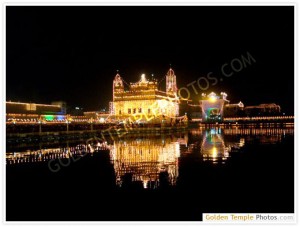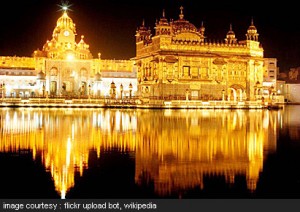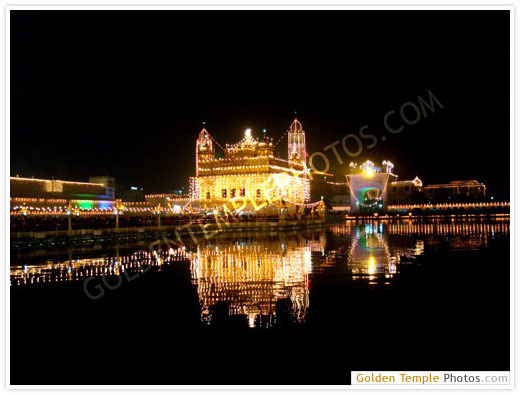Originally posted on 16 Oct 2010 :
On the birth anniversary of Shri Guru Ramdas ji, who founded the city of Amritsar and designed the Golden Temple, there was a befitting function in Amritsar last week. A few pictures of the temple as it looks at night are attached.
As I sat through the telecast, my mind’s eye went back to the events which took place a hundred odd years ago. In 1896, a few youthful devotees suggested that “electricity” be used to light up the sanctum sanatorium and the precincts of the hallowed temple of the Sikhs. They had prepared a detailed plan for the installation of a generator and the transmission system for the purpose.
The reaction of the grey bearded high priests was predictable. They threw a fit. It was totally unacceptable to them. What began was a ‘war’ of sorts. The devotees got divided into two groups : those who supported were dubbed “bijli bhaktas” while the rest considered themselves to be “guru bhaktas” The objections of the opponents can be summarized under the following categories:
Electricity could be dangerous. They cited examples of electrocution, and it was most unwise to expose the devotees to avoidable risk. What if the generator failed? There would be no light in the temple. To install the transmission cables, the walls would need to be tampered with. And that was considered to be an act of sacrilege. For meditation, the light should be gentle. Electric bulbs would dazzle, and interfere with the process of sublime concentration. The butter lamps which were traditionally used in the palces of worship had an aroma, which the electric bulbs did not possess. The opponents of the electrification project issued an edict:
“What the Sikhs need is the ‘light’ emitted by the words of ‘gurus’ and not the dazzle of electric bulbs”
The issue became emotive. Both sides dug in. The battle raged through press and pamphlets were printed and circulated. The high priests threatened to resign.
Then, some one got a bright idea. They decided to send delegations to the places of worship of other faiths : Christianity, Hindu Temples and Kaaba. The emissaries returned with a single message : No one had installed electricity! The stand taken by the high priests stood vindicated. At this point two eminent leaders : Sir Sunder Singh Majithia and the Maharaja of Faridkot stepped in. They suggested that electricity be installed but be confined to the outer periphery of the temple, and if it proved successful, and then be extended to the ‘parikrama’ The inner temple would be kept outside the ‘electricity’ project.
The law of nature followed its course. The temple is illuminated with lights that dazzle not only the eye but even our imagination. And the devotees continue to throng the House of Guru Ramdas ji!
I have an irrepressible urge to quote an Urdu couplet by “Saagar Allahabadi”
Baghaawat jawaanoN ka mazhab hai ‘Saagar’
Udaas budhhapa …. baghawat jawaani”
( To rebel and seek to make a difference is the creed of the youth:
The elderly are despondent, while the young seek change)
The conflict between the young and the old is there to stay; all else may change, as indeed it will!
ELECTRIFICATION OF THE GOLDEN TEMPLE, Whether or not electricity be inducted into the Golden Temple premises was a raging polemic in the closing years of the nineteenth century. There were views pro and con, and the debate was joined by both sides vehemently and unyieldingly. As was then the style of making controversies, religious and social, no holds were barred and no acrimonious word spared to settle the argument. If tradition and usage were drawn upon by opponents, need to move with the limes was urged by the supporters, pejoratively called bijli bhaktas, devotees of electricity.
 The initiative came from the Sri Guru Singh Sabha, Amritsar. At its 23rd annual session, on 26January 1896, it made a formal resolution recommending the installation of electricity in the Golden Temple. Sardar Sundar Singh Majithia told the audience that Sri Harimandar which was in beauty the very image of baikunth, i.e. paradise, by day was shrouded in darkness by night. Many holy and old people who came to do homage late in the evening or in the small hours of the morning suffered injury owing to lack of lighting. Electric light would, pleaded Sardar Sundar Singh, enhance the glory of the Golden Temple and prove a boon to the visiting devotees.
The initiative came from the Sri Guru Singh Sabha, Amritsar. At its 23rd annual session, on 26January 1896, it made a formal resolution recommending the installation of electricity in the Golden Temple. Sardar Sundar Singh Majithia told the audience that Sri Harimandar which was in beauty the very image of baikunth, i.e. paradise, by day was shrouded in darkness by night. Many holy and old people who came to do homage late in the evening or in the small hours of the morning suffered injury owing to lack of lighting. Electric light would, pleaded Sardar Sundar Singh, enhance the glory of the Golden Temple and prove a boon to the visiting devotees.
Col Sardar Javala Singh, the officially appointed manager of the Golden Temple, and Master Narain Singh of Khalsa High School, Gujranwala, endorsed Sardar Sundar Singh’s proposal. An 11 member committee, with Sardar Bahadur Sardar Arjan Singh as president, was set up to carry through (lie plan. The committee secured the support of influential men in the Sikh community such as Baba Sir Khem Singh Bedi, Rai Bahadur Sardar Sujan Singh of Rawalpindi and Sardar Balwant Singh of Attari. Subscription lists were opened and fundraising started in towns and villages.
The lighting committee sent a deputation to wait on Raja Bikram Singh of Faridkot who was the patron of the Khalsa Diwan of Amritsar and helped religious and public causes witli an open hand. Col Javala Singh and Sardar Sundar Singh Majithia, who led the group to Faridkot, returned with an assurance from the Maharaja for financial support. At a meeting held at Akal Takht on 25 April 1897, three of the courtiers sent by the Maharaja of Faridkot announced on his behalf that, in commemoration of the uninterrupted 60 year rule of Queen Victoria, he would have electricity installed in the Golden Temple premises at a cost of Rs 20 thousand.
Then opposition raised its head. In May 1897, three granthls of Golden Temple served a registered notice on Sardar Sundar Singh Majithia, secretary of the lighting committee, censuring the scheme.
On 22 June 1897, the Diamond Jubilee was observed by Sikhs in Amritsar. Kanvar Gajendra Singh, son of the Maharaja of Faridkot, participated in the celebrations. On this occassion, electricity was displayed in the Golden Temple by importing temporarily into the precincts the private generator belonging to Rai Dholan Das.
The Maharaja of Faridkot visited Amritsar on 14 August 1897, and, at a public meeting of the Sikhs, announced a donation of Rs 1 lac for electricity as well as for a new building for Guru ka Langar. Part of the money was invested in a generating set and accessories.
The opponents had not been idle. On 29 July 1897, the executive committee of the Lahore Singh Sabha placed on record its disapproval of the proposal. The three Golden Temple granthis, Bhai Harnam Singh, Bhai Bhagat Singh and Bhai Partap Singh, published a letter in the Khalsa Akhbar Lahore, 27 August 1897, openly attacking the proposal. Argument upon argument was marshalled to show the utter inappropriatcncss of inducting electricity into the sacred premises. The article was repeated in a tract entitled Bijii Biddran (“Demolition of Electricity”),
Electricity was dangerous. To substantiate the point, allusion was made to the title of Government enactment of 1887 which ran as follows: An act to provide for the protection of person and property from the risks incident to the supply and use of electricity for lighting and other purposes. Another extract quoted was from the Civil and Military Gazelle of Lahore, 27 October 1897: “Several persons in America liavc lost their lives in various cities through coming in contact with electric light and power wires.” Instances were mentioned of the damage caused by electricity to a factory in Dharival and the disorder created at the inaugural ceremonies for the opening of Sirhind canal. The granthis argued that there was no precedent of electricity having been installed either in Bethlehem or in Kaaba. Of more than 1500 churches in London, not one had been electrified not even Westminster Abbey. Thirdly, it was urged, custom and tradition sanctioned only illumination by ghee.
Electricity was sheer extravagance. Its dazzle would hinder concentration and meditation. As a coup de grace, the point was pressed that electric light was western and the building of Harimandar eastern. The two were contradictory.
The granthis were backed by pujaris of Takht Sri Abchal Nagar at Nanded, who rejected all other lighting except that by ghee which alone had the necessary sanctity. Babu Teja Singh of Bhasaur, a leading figure in the Singh Sabha renovation, contributed a letter to the Khalsa Akhbar, 3 September 1897, to make the point that the real light the Sikhs needed was for the elimination of distinctions of caste in the community. For Harimandar, lighting by ghee, permitted by their eastern custom, was the most appropriate. Another correspondent in a letter in the Khalsa Akhbar, 27 August 1897, had stated that he had enquired from the Archbishop of the Punjab and learnt that there was no electric light in St. Peter’s or in St. Paul’s. He also recalled the criticism made by Englishmen themselves who termed the Gothic style clocktower beside the Golden Temple a monstrosity. Western light inside the Temple would be similarly offensive, he concluded. Sant Khalsa Dyal Singh of Hoti Mardan joined the fray with an angrily written pamphlet. He said that splitting the roof or walls of the temple to fix electric wiring would be a sacrilege.
In its editorial on 6 August 1897, the Khalsa Akhbaar commented that the Golden Temple was not a museum to wliich people had to be allured by such meretricious display. On 20 August 1897, it praised the Maharaja of Faridkot for his munificence in providing funds for electricity, but satirized Iris friends who had counselled him this kind of extravagance. In the Khalsa Akhbar of 6 August 1897, Sri Guru Singh Sabha of JaIandhar published a note in support of the grant/us. One of the questions raised was: “What will happen if the engine went out of order?” In its editorial the same day, the Khalsa Akhbar wrote:
“What the Sikhs needed was the light of the Gurus’ Word rather than that of electricity.”
 Electricity, when it came, did appear a novelty. Visiting the Golden Temple after an interval of 16 years, Dr John Gampbell Oman, who had been a Professor at Government College at Lahore (1877-97) and Principal of the Khalsa College at Amritsar (1898-99), referred to it in these terms: “… the garish electric light, installed on the temple itself amidst the modest oldworld churchs, looking like an illmannered, obtrusive upstart completely out of its proper element.”
Electricity, when it came, did appear a novelty. Visiting the Golden Temple after an interval of 16 years, Dr John Gampbell Oman, who had been a Professor at Government College at Lahore (1877-97) and Principal of the Khalsa College at Amritsar (1898-99), referred to it in these terms: “… the garish electric light, installed on the temple itself amidst the modest oldworld churchs, looking like an illmannered, obtrusive upstart completely out of its proper element.”
The advocates of bijii had won. But the controversy left behind a trail of bitterness. Essentially, it was a conflict between the Lahore and Amritsar wings of the Singh Sabha. Both were mutually hostile and had persistently wrangled over all sorts of issues, major and minor. But, surprisingly, the Lahore group which styled itself more progressive and derided the Amritsar group for its “conservatism,” was foremost in opposing electricity. Yet it was not able to obstruct the march of events. Electricity would have, in any case, come. But the initiative taken by Sardar Sundar Singh MajTthia and the support given him by the Maharaja of Faridkot will be remembered in history.








[...] Electricity in the Golden Temple : “Guru Bhakta or Bijli Bhakta?” [...]
Telling me?
Ask my daughter!!
By the way, despite technological advances and
becoming, so called developed, have we changed?
Viren
Another piece giving much info about our faith – do write some more on sikhi – we need to know more and especially on the udasis of Guru Nanak Dev ji. How could he travel far and wide without means of travel present today. How he stayed at Mecca for long years where only Muslims are permitted to stay..
You had wanted to know about the work we are doing now. Basically the mission is to bring every child to school – in Chandigarh there are 10000 kids between 6-14 years old who are not attending school as per estimates by the Education deptt. ( There may be many more looking at the floating migrant population).
We are monitoring 16 such centers and have provided 35 libraries and 42 computers to such centers under our ‘”Udaan” Project.
Apart from this the medical check ups of these 500+ kids , deworming etc is also done. Providing woollens and track suits in winter is another project. We hold their drawing and sports competitions and give prizes. Trying to inject quality in the govt system, monthly reports are sent to the Education deptt about each center.
Apart from this we are selecting nearly 100 kids every year for providing scholarships – these are students from govt schools studying in class IX and X. Now we want to start remedial classes for students of Class VII where drop outs are high and there is a dream project of a mobile school Inshaallah!
Dear Surjit,SSA
nteresting info,well presented,ending in wit and wisdom,which is your trade mark